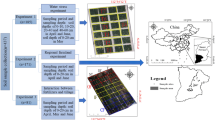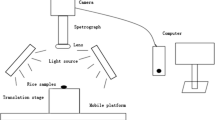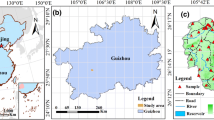Abstract
This study was conducted to develop fast and nondestructive models for the discrimination of different farming methods and to determine the geographical origin of rice samples from different administrative regions in China using near-infrared (NIR) spectroscopy. Principal component analysis (PCA) and partial least squares discriminant analysis (PLS-DA) were applied to build the NIR spectral models. Norris smoothing derivative (NSD) and multiplicative scatter correction (MSC) were used as preprocessing methods to reduce the spectral noise and enhance effective information. The results show that it was difficult to distinguish the farming methods with the original spectra plots and PCA score plots except for the rice samples from Heilongjiang Province. In addition, a PLS-DA model combined with NSD preprocessing provided the optimal predictive accuracy of 89.7% for the identification of different farming methods. NSD or MSC preprocessing combined with PLS-DA models provided the best discrimination of the origin traceability. The total accuracy of Northeast China rice samples was 100%, and of the South, East, Central and Southwest China rice samples was 98.2%. The total accuracy of Heilongjiang, Anhui, Jiangsu, Hubei, and Sichuan Provinces were 100%, 98.8%, 95.3%, 95.3%, and 93.6%, respectively. These indicate that NIR combined with PLS-DA and NSD or MSC preprocessing can provide a powerful method to distinguish the different farming methods and geographical origin of Chinese rice.






Similar content being viewed by others
Data availability statement
The date that supports the findings of this study are available in the supplementary material of this article.
References
M. Arndt, A. Drees, C. Ahlers, M. Fischer, Determination of the geographical origin of walnuts (Juglans regia L) using near-infrared spectroscopy and chemometrics. Foods 9(12), 1860 (2020). https://doi.org/10.3390/foods9121860
H. Ayvaz, M. Plans, B.N. Towers, A. Auer, L.E. Rodriguez-Saona, The use of infrared spectrometersto predict quality parameters of cornmeal (corn grits) and differentiate between organic and conventional practices. J. Cereal Sci. 62, 22–30 (2015). https://doi.org/10.1016/j.jcs.2014.12.004
A. Biancolillo, F. Marini, C. Ruckebusch, R. Vitale, Chemometric strategies for spectroscopy-based food authentication. Appl. Sci. 10(18), 6544 (2020). https://doi.org/10.3390/app10186544
R.G. Brereton (2009) Chemometrics for pattern recognition. Wiley https://doi.org/10.1002/9780470746462.ch4
B.S. Buslig, Nondestructive measurement of quality of fruits and vegetables. Proc. Fla. State Hortic. Soc. 103, 291–291 (1991)
C. Yi, M.Y. Xie, Y. Yan, S.B. Zhu, S.P. Nie, C. Li, Y.X. Wang, X.F. Gong, Discrimination of ganoderma lucidum according to geographical origin with near infrared diffuse reflectance spectroscopy and pattern recognition techniques. Anal. Chim. Acta 618(2), 121–130 (2008). https://doi.org/10.1016/j.aca.2008.04.055
D. Cozzolino, E. Restaino, A. Fassio, Discrimination of yerba mate (Ilex paraguayensis St. Hil) samples according to their geographical origin by means of near infrared spectroscopy and multivariate analysis. Sens. Instrum. Food Qual. Saf 4(2), 67–72 (2010). https://doi.org/10.1007/s11694-010-9096-y
J.P. Cruz-Tirado, J.A.F. Pierna, H. Rogez, D.F. Barbin, V. Baeten (2020) Authentication of cocoa (Theobroma cacao) bean hybrids by NIR-hyperspectral imaging and chemometrics. Food Control 118. https://doi.org10.1016/j.foodcont.2020.107445
L.M. Dale, A. Thewis, C. Boudry, I. Rotar, F.S. Curar, O. Abbas, P. Dardenne, V. Baeten, J. Pfister, J.A. Fernández Pierna, Discrimination of grassland species and their classification in botanical families by laboratory scale NIR hyperspectral imaging: preliminary results. Talanta 116, 149–154 (2013). https://doi.org/10.1016/j.talanta.2013.05.006
M.S. Dhanoa, S.J. Lister, R. Sanderson, R.J. Barnes, The link between multiplicative scatter correction (MSC) and standard normal variate (SNV) transformations of NIR spectra. J. Near Infrared Spectrosc. 2(1), 43–47 (1994). https://doi.org/10.1255/jnirs.30
Y. Hao, P. Geng, W. Wu, Q. Wen, M. Rao, Identification of rice varieties and transgenic characteristics based on near-infrared diffuse reflectance spectroscopy and chemometrics. Molecules 24(24), 4568 (2019). https://doi.org/10.3390/molecules24244568
J. Huang, S. Rozelle, R. Hu, N. Li(2002) China’s rice economy and policy: Supply, demand, and trade in the 21st century. Developments in the Asian rice economy 3–5
L.F. Huang, Y.U. Jun, Y. Jie, R. Zhang, Y. Bai, C. Sun, H. Zhuang, Relationships between yield, quality and nitrogen uptake and utilization of organically grown rice varieties. Pedosphere 26(1), 85–97 (2016). https://doi.org/10.1016/S1002-0160(15)60025-X
M. Janssen, U. Hamm, Governmental and private certification labels for organic food: consumer attitudes and preferences in Germany. Food Policy 49, 437–448 (2014)
J.K.G. Kramer, H. Azizian, FT-NIR the method of choice to verify the authenticity of extra virgin olive oils. NIR news 28(4), 6–9 (2017). https://doi.org/10.1177/0960336017707869
D. Krstajic, L.J. Buturovic, D.E. Leahy, S. Thomas, Cross-validation pitfalls when selecting and assessing regression and classification models. J. Cheminf 6(1), 1–15 (2014). https://doi.org/10.1186/1758-2946-6-10
C. Li, H. Dong, D.H. Luo, Y.P. Xian, X. Fu, Recent developments in application of stable isotope and multi-element analysis on geographical origin traceability of cereal grains. Food Anal. Methods 9(6), 1512–1519 (2016). https://doi.org/10.1007/s12161-015-0328-y
M. Li, R. Li, S. Liu, J. Zhang, H. Luo, S. Qiu, Rice-duck co-culture benefits grain 2-acetyl-1-pyrroline accumulation and quality and yield enhancement of fragrant rice. Crop J. 7(4), 419–430 (2019). https://doi.org/10.1016/j.cj.2019.02.002
G.P.P. Lima, F. Vianello, Review on the main differences between organic and conventional plant-based foods. Int. J. Food Sci. Technol. 46(1), 1–13 (2011). https://doi.org/10.1111/j.1365-2621.2010.02436.x
H. Liu, Y. Wei, Y. Zhang, S. Wei, S. Zhang, B. Guo (2017) The effectiveness of multi-element fingerprints for identifying the geographical origin of whea. Int. J. Food Sci. Technol. 52(4) https://doi.org/10.1111/ijfs.13366
X. Liu, Z. Liu, Q. Qian, W. Song, Y. Yuan (2020a) Isotope chemometrics determines farming methods and geographical origin of vegetables from Yangtze River Delta Region, China. Food Chem. 342: 128379. https://doi.org/10.1016/j.food chem.2020a.128379
X. Liu, Y.Z. Rong, X. Zhang, D. Mao, Y. Yang, Z. Wang, Rapid determination of total dietary fiber and minerals in Coix seed by near-infrared spectroscopy technology based on variable selection methods. Food Anal. Methods 8(7), 1607–1617 (2015). https://doi.org/10.1007/s12161-014-0037-y
Y. Liu, Y. Li, Y. Peng, Y. Yang, Q. Wang, Detection of fraud in high-quality rice by near‐infrared spectroscopy. J. Food Sci. 85(9), 2773–2782 (2020b). https://doi.org/10.1111/1750-3841.15314
Z. Liu, Y. Yuan, T. Xie, Y. Zhang, S. Shao, J. Nie, W. Xia, K. Rogers, W. Zhang, Long-term agricultural effects on the authentication accuracy of organic, green, and conventional rice using isotopic and elemental chemometric analyses. J. Agric. Food Chem. 68(5), 1213–1225 (2020c). https://doi.org/10.1021/acs.jafc.9b06847
D. Luo, H. Dong, H. Luo, Y. Xian, J. Wan, X. Guo, Y. Wu, The application of stable isotope ratio analysis to determine the geographical origin of wheat. Food Chem. 174, 197–201 (2015). https://doi.org/10.1016/j.foodchem.2014.11.006
K. Matsumura, R.J. Hijmans, Y. Chemin, D. ElvidgeC, K. Sugimoto, W. Wu, Y. Lee, R. Shibasaki, Mapping the global supply and demand structure of rice. Sustain. Sci 4(2), 301–313 (2009)
A. Mihailova, S.D. Kelly, O.P. Chevallier, C.T. Elliott, A. Cannavan, High-resolution mass spectrometry-based metabolomics for the discrimination between organic and conventional crops: a review. TRENDS FOOD SCI TECH 110, 142–154 (2021). https://doi.org/10.1016/j.tifs.2021.01.071
Y. Ni, M. Mei, S. Kokot, Analysis of complex, processed substances with the use of NIR spectroscopy and chemometrics: classification and prediction of properties—the potato crisps example. CHEMOMETR INTELL. LAB. 105(2), 147–156 (2010). https://doi.org/10.1016/j.chemolab.2010.12.003
T. Næs, T. Isaksson, T. Fearn, T. Davies (2002) A user-friendly guide to multivariate calibration and classification. https://doi.org/10.1255/978-1-906715-25-0
M. Plans, J. Simó, F. Casañas, J. Sabate, L. Rodriguez-Saona, Characterization of common beans (Phaseolus vulgaris L.) by infrared spectroscopy: comparison of MIR, FT-NIR and dispersive NIR using portable and benchtop instruments. Food Res. Int. 54(2), 1643–1651 (2013). https://doi.org/10.1016/j.foodres.2013.09.003
J.P. Reganold, J.M. Wachter, Organic agriculture in the twenty-first century. Nat. Plants 2(2), 1–8 (2016)
A. Savitzky, M.J.E. Golay, Smoothing and differentiation of data by simplified least squares procedures. Anal. Chem. 36(8), 1627–1639 (1964). https://doi.org/10.1021/ac60214a047
V. Seufert, N. Ramankutty, J.A. Foley, Comparing the yields of organic and conventional agriculture. NATURE 485(7397), 229–232 (2012). https://doi.org/10.1038/nature11069
M. Thitisaksakul, R.C. Jiménez, M.C. Arias, D.M. Beckles, Effects of environmental factors on cereal starch biosynthesis and composition. J. Cereal Sci. 56(1), 67–80 (2012). https://doi.org/10.1016/j.jcs.2012.04.002
J. Wang, T. Chen, W. Zhang, Y. Zhao, A. Chen, Tracing the geographical origin of rice by stable isotopic analyses combined with chemometrics. Food Chem. 313, 126093 (2020). https://doi.org/10.1016/j.foodchem.2019.126093
L. Wang, F.S.C. Lee, X. Wang, Y. He, Feasibility study of quantifying and discriminating soybean oil adulteration in camellia oils by attenuated total reflectance MIR and fiber optic diffuse reflectance NIR. Food Chem. 95(3), 529–536 (2006). https://doi.org/10.1016/j.foodchem.2005.04.015
R. Xiao, L. Liu, D. Zhang, Y. Ma, M.O. Ngadi, Discrimination of organic and conventional rice by chemometric analysis of NIR spectra: a pilot study. J. Food Meas. Charact. 13(1), 238–249 (2019). https://doi.org/10.1007/s11694-018-9937-7
Z. Yi, The Study of Problem and Improvement of China’s Organic Food Certification System (Food Research and Development, 2013)
J. Zhao, A. Chen, X. You, Z. Xu, S. Yang, A panel of SNP markers for meat traceability of halal beef in the chinese market. Food Control 87, 94–99 (2018). https://doi.org/10.1016/j.foodcont.2017.11.039
Funding
The authors acknowledge the financial support by Hunan seed industry innovation project (No. 2021NK1001), State Key Laboratory of Hybrid Rice, Hunan Hybrid Rice Research Center opening project (No. 2021KF004).
Author information
Authors and Affiliations
Contributions
J.W. and B.B.: conceptualization, funding acquisition, methodology, project administration, supervision; H.H. and Q.D.: methodology, supervision, reviewing, and editing; D.W. and X.L.: conceptualization, formal analysis, investigation, visualization, methodology, and writing the original draft; J.W. and R.W. and Y.Z.: investigation, visualization, methodology. All authors reviewed the manuscript.
Corresponding authors
Ethics declarations
Conflict of interest
The authors declare that they have no conflict of interest.
Ethical approval
This article does not contain any studies with human or animal subjects.
Informed consent
Not applicable.
Additional information
Publisher’s note
Springer Nature remains neutral with regard to jurisdictional claims in published maps and institutional affiliations.
Rights and permissions
Springer Nature or its licensor (e.g. a society or other partner) holds exclusive rights to this article under a publishing agreement with the author(s) or other rightsholder(s); author self-archiving of the accepted manuscript version of this article is solely governed by the terms of such publishing agreement and applicable law.
About this article
Cite this article
Wu, D., Liu, X., Bai, B. et al. Determining farming methods and geographical origin of chinese rice using NIR combined with chemometrics methods. Food Measure 17, 3695–3708 (2023). https://doi.org/10.1007/s11694-023-01901-z
Received:
Accepted:
Published:
Issue Date:
DOI: https://doi.org/10.1007/s11694-023-01901-z




